Everything in the G text appears to be the
opposite of what can be perceived in the C text - 'upside down'. For instance
is it easy to identify heliacal Polaris towards the
end of side b (at a glyph which possibly could be alluding to 'bending over' like the
Southern Cross beyond midnight)
... How often have we heard our guides exclaim in the savannahs
of Venezuela and in the desert extending from Lima to Truxillo,
'Midnight is past, the Cross begins to bend' ...
- in contrast to nakshatra Acrux at the
beginning of side a on the C tablet.
In Roman times Polaris would have indicated where the Sun
was about to reach 0h whereas in rongorongo times Acrux close to
the Full Moon would have indicated the position of
the southern spring equinox. South of the equator, on Easter
Island, summer stretched from the time when Acrux was close to
the Full Moon to the time when the Full Moon reached the region
of Polaris.
|
Moai
Statue, figurine, likeness of a person or
of an animal; moai ma'ea, stone statue; moai
miro, wooden statue, moai toromiro, toromiro
figurine. Vanaga.
H. Bending over, arching like a tree.
Barthel 2. |
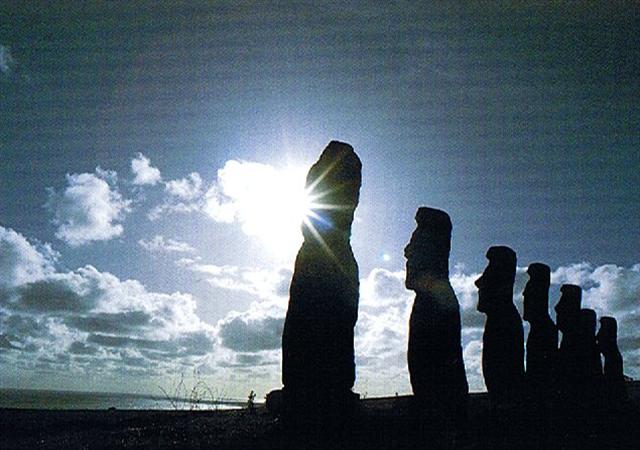
... Take the lower
part of a gourd or hula drum, rounded as a wheel (globe),
on which several lines are to be marked and burned in, as
described hereafter. These lines are called na alanui o na
hoku hookele, the highways of the navigation stars, which
stars are also called na hoku ai-aina, the stars which
rule the land. Stars lying outside these three lines are called
na hoku a ka lewa, foreign, strange, or outside stars.
The first
line is drawn from Hoku-paa, the fixed or North Star, to
the most southerly star of Newe, the Southern Cross ...
This sign of 'bending over' (moai)
preceding the 'rising fish' with its vaha mea
- red opening (mouth) - at 0h (the Gregorian equinox) was
perhaps the result of having extrapolated backwards to Roman times, to
'March 21 (The First Point of Aries).
The Mayas wrote from right to
left and their open (red) mouth in the spring month
Zotz was therefore at left (in front)
in their glyph:
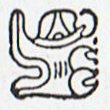
A pair of 'eyes' at the beginning (at
right) closed the season of such 'turtle' eyes
which were emerging towards the end of Vayeb:
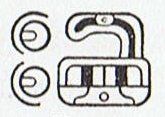
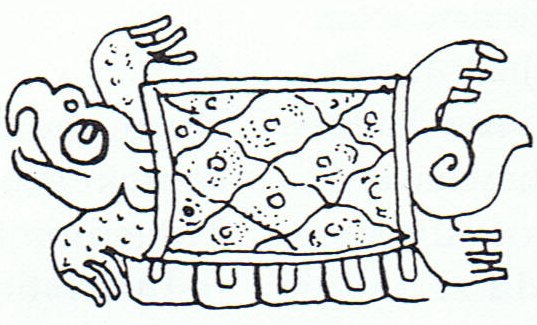
Essentially the same signs
were used in Gb7-24--25 as those early on side a in Ga1-3--4 - there for the important
ancient time of the Bull when the Julian equinox had been at
heliacal Aldebaran:
|
FEBRUARY
9 |
10 |
11 (42) |
12 (408) |
13
(*329) |
 |
 |
 |
 |
 |
|
Gb7-22 |
Gb7-23
(204) |
Gb7-24
(80 + 354) |
Gb7-25 |
Gb7-26
(436) |
|
ALSEIPH
= φ Persei
(24.5), τ Ceti (24.7) |
no star
listed (25) |
ANA-NIA-10 (Pillar-to-fish by)
χ Ceti
(26.1),
POLARIS
= α Ursae Minoris, BATEN KAITOS = ζ Ceti
(26.6),
METALLAH
= α Trianguli
(26.9) |
Al
Sharatain-1 /
Ashvini-1 /
Bond-16
/
Mahrū-sha-rishu-ku-1
(Front of the Head of
Ku)
SEGIN =
ε Cassiopeia, MESARTHIM = γ Arietis, ψ Phoenicis
(27.2),
SHERATAN
= β Arietis, φ Phoenicis
(27.4) |
ι
Arietis (28.0), λ Arietis (28.2), υ Ceti (28.8) |
|
4-14
(104) |
April 15
(*25) |
16 (471) |
17 (107) |
18 (*393) |
|
°April 10 (100) |
11 (466) |
12 |
13 |
14 (104) |
|
'March 18 |
19 (78) |
20
(*364) |
0h (80) |
22 |
|
"March 4 (428) |
5 (64) |
6 (*350) |
7 |
8 |
|
35 |
0h (80 +
365) |
MARCH 22
(*1) |
23 (82) |
|
no glyph |
 |
 |
|
Ga1-1 |
Ga1-2 |
|
HYADUM II =
δ¹ Tauri
(64.2) |
Net-19
AIN
(Eye)
= ε Tauri, θ¹ Tauri, θ² Tauri
(65.7) |
no star
listed (66) |
|
May 24 (*64
= 8 * 8) |
25 (145 = 290 / 2) |
26 (146 = 2
* 73) |
|
°May 20
(140) |
21 (*61) |
22 |
|
'April 27 |
28 (118 = 4
* 29½) |
29 (*39 = 3
* 13) |
|
"April 13 |
14 (104 = 8
* 13) |
15 (*25 = 5
* 5) |
In a way, therefore, it could be said that
heliacal Aldebaran - instead of nakshatra Acrux as in C - was the
true beginning of the G text. However, traditionally it was not
Aldebaran but the Front of the Head of Ku which was
at the beginning:
|
BABYLONIAN
ECLIPTIC CONSTELLATIONS: |
|
0 |
1-iku |
Field
measure |
τ
(Anunitum)
Piscium |
16.5 |
April 6
(96) |
| |
|
1 |
Mahrū-sha-rishu-ku |
Front of
the Head of Ku |
β
(Sheratan),
γ (Mesarthim) Arietis |
27.4 |
April 17
(107) |
|
2 |
Arku-sha-rishu-ku |
Back of
the Head of Ku |
α
(Hamal)
Arietis |
30.5 |
April 20
(110) |
| |
|
3 |
Temennu |
Foundation Stone |
η
(Alcyone)
Tauri |
56.1 |
May 16
(136) |
|
4 |
Pidnu-sha-Shame |
Furrow
of Heaven |
α
(Aldebaran)
Tauri |
68.2 |
May 28
(148) |
Hamal and the precessionally
following Sheratan were uplifted from the waters
like a new Land emerging from the deeps,
... What
happens after (or happened, or will happen sometime, for
this myth is written in the future tense), is told in the
Völuspa, but it is also amplified in Snorri's
Gylfaginning (53), a tale of a strange encounter of King
Gylfi with the Aesir themselves, disguised as men, who do
not reveal their identity but are willing to answer
questions: 'What happens when the whole world has burned up,
the gods are dead, and all of mankind is gone? You have said
earlier, that each human being would go on living in this or
that world.' So it is, goes the answer, there are several
worlds for the good and the bad. Then Gylfi asks: 'Shall any
gods be alive, and shall there be something of earth and
heaven?' And the answer is:
'The earth
rises up from the sea again, and is green and beautiful and
things grow without sowing. Vidar and Vali are alive, for
neither the sea nor the flames of Surt have hurt them and
they dwell on the Eddyfield, where once stood Asgard. There
come also the sons of Thor, Modi and Magni, and bring along
his hammer. There come also Balder and Hoder from the other
world. All sit down and converse together. They rehearse
their runes and talk of events of old days. Then they find
in the grass the golden tablets that the Aesir once played
with.
Two children of
men will also be found safe from the great flames of Surt.
Their names, Lif and Lifthrasir, and they feed on the
morning dew and from this human pair will come a great
population which will fill the earth. And strange to say,
the sun, before being devoured by Fenrir, will have borne a
daughter, no less beautiful and going the same ways as her
mother.'
Then, all at
once, concludes Snorri's tale wryly, a thunderous cracking
was heard from all sides, and when the King looked again, he
found himself on the open plain and the great hall had
vanished ...
- they were uplifted by the head
of Cetus, which creature therefore should have been Ku:
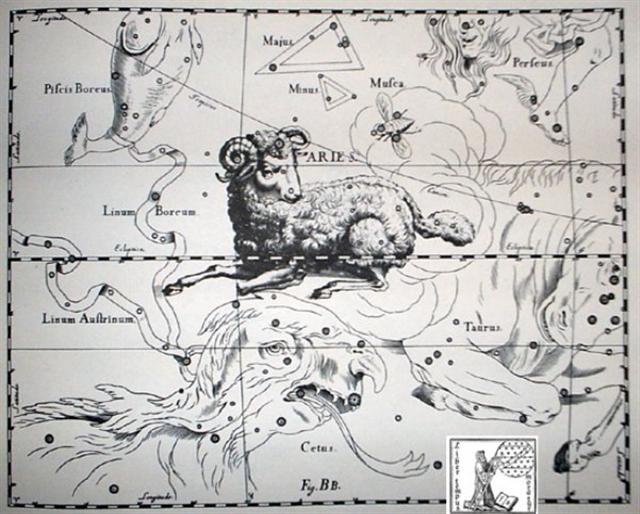
Hamal was at 0h around (30.5 - 27.4) * 26000
/ 366 = 220 years earlier than Sheratan. Perhaps this was
the reason why Aries had his head turned around - i.e. in
order to put Hamal first. But in the cycle of the year the
Face of Ku (Sheratan) rose earlier than the back of
his head (Hamal).
... Strassmeier
and Epping, in their Astronomishes aus Babylon, say
that there its stars formed the third of the twenty-eight
ecliptic constellations, - Arku-sha-rishu-ku,
literally the Back of the Head of Ku, - which had been
established along that great circle milleniums before our
era; and Lenormant quotes, as an individual title from
cuneiform inscriptions, Dil-kar, the Proclaimer of
Dawn, that Jensen reads As-kar, and others Dil-gan,
the Messenger of Light.
George Smith
inferred from the tablets that it might be the Star of
the Flocks; while other Euphratean names have been Lu-lim,
or Lu-nit, the Ram's Eye; and Si-mal or
Si-mul, the Horn star, which came down even to late
astrology as the Ram's Horn.
It also was
Anuv, and had its constellation's titles I-ku and
I-ku-u, - by abbreviation Ku, - the Prince, or
the Leading One, the Ram that led the heavenly flock, some
of íts titles at a different date being applied to Capella
of Auriga.
Brown
associates it with Aloros, the first of the ten mythical
kings of Akkad anterior to the Deluge, the duration of whose
reigns proportionately coincided with the distances apart of
the ten chief ecliptic stars beginning with Hamal, and he
deduces from this kingly title the Assyrian Ailuv,
and hence the Hebrew Ayil; the other stars
corresponding to the other mythical kings being Alcyone,
Aldebaran, Pollux, Regulus, Spica, Antares, Algenib, Deneb
Algedi, and Scheat ...
For the record:
KU, v.
Haw., to rise up, stand, let go,
let fall, hit, strike against,
resist; ku-e, to oppose,
resist; ku-i, to pound,
beat, knock; ku'-u, let
go, loosen, put down; ku-ku,
to strike, beat, stand up, be
high, excel; ku-a, to
strike horizontally, to cut
down, as trees, to fell, throw
away.
N. Zeal.,
tu, stand; tuki,
beat, knock; tuku, allow,
permit. Sam., tu,
stand up, arise, to take place,
come to pass; s. a
custom, habit; tu-i, to
thump, beat, pound; s. a
blow with the fist, a curse;
tu'ia, to strike, as the
foot against a stone;
tu'i-fao, a blacksmith
(mod.), lit. a pounder of nails;
tu'u, to place, appoint,
permit, let go, set free, cut
down, desist. Tah., tu,
stand erect, to fit, agree;
tu-a, to cut, to rest or
wait; tu-e, to impel,
strike with the foot, hit
against; tu'e-tu'e, to
oppose; tu-i, to butt,
strike, smite; tutu, to
strike, beat; tu'u, let
go, dismiss, yield.
Fiji, tu,
to stand; tuki, beat,
knock; tuku, let go,
slack up:
Sunda,
tutut, loose, slack.
The same
dialectical variations in form
and sense obtain through all the
Polynesian groups. Two original
conceptions seem to have
attatched themselves to the
Polynesian root-word ku,
tu, viz., (1.) 'To rise,
stand, be prominent'; (2.) 'To
strike, put down, let go.' The
West Aryan relatives of this
Polynesian ku, tu,
appear to have confined
themselves to the second
conception of the word, 'to
strike, put down, let go',
although the probably oldest of
these forms, the Vedic tu,
bears the general sense 'to be
powerful'. To mention but
a few of these Aryan
correlatives, we find -
Sanskr., tu
(Ved.), be powerful, to
increase, to hurt; tuy
and tunj,
to strike, push, abide, give or
take; tud, to strike,
sting; tund, be active;
tup, tump,
tumbh, to hurt, kill;
khud (Ved.), kshud,
to push, to pound. Lat., cudo,
strike, beat, sting; incus,
an anvil; tundo (tutudi),
to beat, strike, pound;
tussis, a cough; tueor,
guard, watch, keep; tutus,
safe; tuber, tumor,
tumulus; stupeo,
be stunned, benumbed. Greek,
τυπος,
a blow; τυπτω,
έτυπτον,
to beat, strike;
τυλη,
τυλος,
a knot or callus, a lump, hump,
knob, a cushion;
τυλυγμα,
a wheal, swelling: Liddell and
Scott refer this latter to
Sanskrit
tu.
Goth.,
stautan,
to strike, smite. Germ.,
stossen.
Dutch,
stooten.
Benfey (Sanskr.-Engl. Dict.) s.
v. Tud,
considers that the Gothic has
retained an original
s,
which the Sanskrit and the other
dialects have lost. With all due
deference to so great authority,
yet, if Professor Max Müller is
correct, that the oldest forms
of Aryan speech consisted of
open syllables of one consonant
and one vowel, or of one vowel,
and judging from the analogy of
the Polynesian, I should look
upon all prefixes and suffixes
to a simple root or stem as of
later growth, and hence that the
s
in question, like the
s
in
stupeo,
indicates a later period than
that when
tu
or tup
were used to express the sense
of striking, beating, stunning.
Anc. Slav.,
kuti
or
kowati,
a smith. Lith.,
kujis,
a hammer;
kauti,
to fight.
To this Vedic and Polynesian
root,
tu,
'to be powerful, increase, rise
up', refers itself, doubtless, a
word expressing family relation
throughout Polynesia, but which
in its simple form has become
almost obsolete, except in Fiji.
In the Polynesian groups proper
it always occurs in composites,
sometimes with the other family
designation,
kai,
prefixed, sometimes with the
intensive prefix
ma,
sometimes without either. That
word is -
KUA, s.
Haw., obsol. Fiji., tuka,
grandfather; tua, word
used by children to their
grandparents; tuaka, an
elder brother or an elder
sister. Sam., tua'a.
N .Zeal., tuaka-na. Tah.,
tu-a'ana. Haw.,
kai-kua'ana. Marqu.,
tuakana, id.
Sam.,
tuangane, a woman's brother.
Haw., kai-kunane, id.
Tah., tuaane, id. Marqu.,
tuanane, id. Sam., Tong.,
tuafafine. Haw.,
kai-ku-wahine. N. Zeal.,
Tah., tuahine; Marqu.,
tuehine, the sister of a
man,
Sam., Tong.,
N. Zeal., Haw., ma-tua,
ma-kua, a parent. Rarot.,
Tah., metua, id. Mangar.,
ma-tua, id. It also
signifies full-grown, old,
elderly. In Tah.,
oro-ma-tua means ancestor.
In Sam.,
ulu-ma-tua means the
first-born, while tua
simply means the child next to
the eldest.
In the Indian
Archipelago this word meets us
under analogous circumstances.
Sula Islands, tua,
husband. Malay., tuan,
tuhan, master, lord.
Pulo-Nias, ira matua,
husband. Kei Islands, ebtuan,
old. Malg., tump,
tumpu, master, the top of a
thing; tupun, id., chief
of an expedition; tu-vuan,
seed, increase; tuku-tan,
a hill, rising ground.
Sanskr.,
toka, offspring, child.
Ved., tuch, offspring.
Greek, τοκας,
she who has just brought forth,
a mother; τοκος,
birth, offspring, child. Liddell
and Scott refer these words to
τικτω,
after Curtius, to one of three
roots, τεκ,
τυκ,
τιχ,
each one equivalent to the
Sanskrit ţaksh,
to prepare, form.
Under correction again, it does
appear to me that if the Greek
τικτω
and its derivatives and variants
refer themselves to the Sanskrit
ţaksh,
certainly the Vedic
tuch
does not descend to the same
origin, but, on the contrary,
allies itself with a better
reason to the Zend
tuchm,
germ, seed, the Sanskit
toka,
the Greek τοκας,
the Polynesian tuka,
whose common root would be the
Vedic and Polynesian
tu,
prevalere, crescere, erigere.
I am well aware of the frequent
and often inexplicable
permutation of vowels, not
seldom leading to false analogy,
in words descending from the
same root, but, at the risk of
making false analogy myself, I
believe that, in the majority of
cases, the Sanskrit nouns in
o
have their roots in
u,
and hence the Sanskrit
toka
may, with perfect propriety and
almost absolute certainty, be
referred direct and primarily to
tu.
In Tahitian alone among the
Polynesian dialects, so far as I
know, this word, derived from
tu,
has retained a sense which
brings it into close relation
with some of the West Aryan
tongues. In Tahitian,
tua,
s. means also 'a company of
people, a flock, a heard'. Its
Indo-European correlatives will
be found in -
Irish,
tuath,
tuad,
people. Welsh,
tut,
people, nation. Umbr.,
tota,
oscau,
touto,
precinct of a town, primarily
people or tribe (A. Pictet).
Lett.
tauta,
people, country. Goth.,
thiuda;
A.-Sax.,
theod,
people.
For my remarks on the relation
of the Polynesian word
atua,
god, spirit, supernatural being,
to ku
vel tu
and tua,
see my work, 'Polynesian Race',
&c, vol. ii. p. 365."
|
... According to an etiological Hawaiian myth,
the breadfruit originated from the sacrifice of
the war god Kū. After deciding to live
secretly among mortals as a farmer, Ku
married and had children. He and his family
lived happily until a famine seized their
island. When he could no longer bear to watch
his children suffer, Ku told his wife
that he could deliver them from starvation, but
to do so he would have to leave them.
Reluctantly, she agreed, and at her word, Ku
descended into the ground right where he had
stood until only the top of his head was
visible. His family waited around the spot he
had last been day and night, watering it with
their tears until suddenly a small green shoot
appeared where Ku had stood. Quickly, the
shoot grew into a tall and leafy tree that was
laden with heavy breadfruits that Ku's
family and neighbors gratefully ate, joyfully saved from
starvation ...

|










